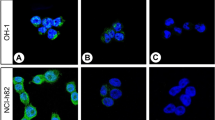Abstract
GGT 129, a polyclonal antibody directed against gamma-glutamyltranspeptidase (GGT), was used to study GGT expression in formalin-fixedparaffin-embedded tissues from normal breast, 24 benign lesions, 27 in situcarcinomas or atypical hyperplasias, and 79 infiltrating mammary carcinomas.Epithelium of the ducts and ductules in normal breast tissue showedimmunoreactivity along the apical surface. There was a strong correlation (P< 0.01) between the histologic classification of the tissue and GGTexpression. All of the benign breast lesions stained positive for GGT. Amongin situ carcinomas and atypical hyperplasias, 5/27 (19%) werenegative for GGT while 22/27 were immunopositive. Infiltrating carcinomasshowed the greatest deviation from normal tissue with 23/79 (29%)negative for GGT. GGT expression in benign and malignant breast tissue wasnot correlated with the age of the patient, suggesting that menopausalstatus does not influence expression of GGT. Correlation of GGTimmunoreactivity with tubule formation, nuclear pleomorphism, mitoses,grade, size of tumor, lymph node status, and ER/PR status was performed for69 cases of infiltrating ductal adenocarcinoma. There were no statisticallysignificant relationships between the level of GGT immunoreactivity and anyof the parameters. The loss of GGT in some of the cases is evidence thatthis enzyme is not required for mammary tumor development or maintenance.However, as GGT is a component of the pathways that metabolize glutathioneand glutathione-conjugates, the difference in levels of the enzyme ininvasive breast cancers may be one explanation for the variation inchemotherapy response that has been observed in patients treated foradvanced mammary cancer.
Similar content being viewed by others
References
Boring CC, Squires TS, Tong T: Cancer statistics, 1991. CA-Cancer J Clin 41: 19–36, 1991
Hanigan MH, Ricketts WA: Extracellular glutathione is a source of cysteine for cells that express gamma-glutamyl transpeptidase. Biochemistry 32: 6302–6306, 1993
Hanigan MH, Frierson HF Jr: Immunohistochemical detection of gamma-glutamyl transpeptidase in normal human tissue. J Histochem Cytochem 44: 1101–1108, 1996
El-akawi Z, Abu-hadid M, Perez R, Glavy J, Zdanowicz J, Creaven PJ, Pendyala L: Altered glutathione metabolism in oxaliplatin resistant ovarian carcinoma cell. Cancer Lett 105: 5–14, 1996
Ahmad S, Okine L, Wood R, Aljian J, Vistica DT: Gammaglutamyltranspeptidase and maintenance of thiol pools in tumor cells resistant to alkylating agents. J Cell Physiol 131: 240–246, 1987
Lewis AL, Hayes JD, Wolf CR: Glutathione and glutathione-dependent enzymes in ovarian adenocarcinoma cell lines derived from a patient before and after the onset of drug resistance: intrinsic differences and cell cycle effects. Carcinogenesis 9: 1283–1287, 1988
Lau HM, Lewis AD, Ehsan MN, Sikic BI: Multifactorial mechanisms associated with broad cross-resistance of ovarian carcinoma cells selected by cyanomorpholino doxorubicin. Cancer Res 51: 5181–5187, 1991
Godwin AK, Meister A, O'Dwyer PJ, Huang CS, Hamilton TC, Anderson ME: High resistance to cisplatin in human ovarian cancer cell lines is associated with marked increase of glutathione synthesis. Proc Natl Acad Sci USA 89: 3070–3074, 1992
Fiala S, Trout EC Jr, Teague CA, Fiala ES: Gamma-glutamyltransferase, a common marker of human epithelial tumors. Cancer Detection and Prevention 3: 471–485, 1980
Hanigan MH, Frierson HF Jr, Brown JE, Lovell MA, Taylor PT: Human ovarian tumors express gamma-glutamyl transpeptidase. Cancer Res 54: 286–290, 1994
Gerber MA, Thung SN: Enzyme patterns in human hepatocellular carcinoma. Am J Pathol 98: 395–400, 1980
Dempo K, Elliot KAC, Desmond W, Fishman WH: Demonstration of gamma-glutamyl transferase, alkaline phosphatase, CEA and HCG in human lung cancer. Oncodev Biol Med 2: 21–37, 1981
Levine SE, Budwit DA, Michalopoulos GK, Georgiade GS, McCarty KS Jr: Gamma-glutamyl transpeptidase activity in benign and malignant human mammary epithelial lesions. Arch Pathol Lab Med 107: 423–427, 1983
Bard S, Noel P, Chauvin F, Quash G: Gamma-glutamyl transpeptidase activity in human breast lesions: an unfavorable prognostic sign. Brit J Cancer 53: 637–642, 1986
Elston CW, Ellis IO: Pathological prognostic factors in breast cancer. I. The value of histological grade in breast cancer: experience from a large study with long-term follow up. Histopathology 19: 403–410, 1991
Dawson J, Smith GD, Boak J, Peters TJ: Gamma-glutamyl-transferase in human and mouse breast tumors. Clin Chim Acta 96: 37–42, 1979
Neuwald PD, Anderson C, Salivar WO, Aldenderfer PH, Dermody WC et al.: Expression of oncodevelopmental gene products by human tumor cells in culture. JNCI 64: 447–459, 1980
Fisher ER, Gregorio RM, Fisher B: The pathology of invasive breast cancer: a syllabus from findings of the national surgical adjuvant breast project (Project No. 4). Cancer 36: 1–84, 1975
Horiuchi S, Inoue M, Morino Y: Gamma-glutamyl transpeptidase sidedness of its active site on renal brush border membrane. Eur J Biochem 87: 429–437, 1978
Meredith MJ, Williams GM: Intracellular glutathione cycling by γ-glutamyl transpeptidase in tumorigenic and non-tumorigenic cultured rat liver cells. J Biol Chem 261: 4986–4992, 1986
Perry RR, Levin M, Barranco SC: Glutathione levels and variability in breast tumors and normal tissue. Cancer 72: 783–787, 1993
Friedman HS, Colvin OM, Kaufmann SH, Ludeman SM, Bullock N, Bigner DD, Griffith OW: Cyclophosphamide resistance in medulloblastoma. Cancer Res 52: 5373–5378, 1992
Canada A, Herman L, Kidd K, Robertson C, Trump D: Glutathione depletion increases the cytotoxicity of melphalan to PC-3, an androgen-insensitive prostate cancer cell line. Cancer Chemother Pharmacol 32: 73–77, 1993
Hanigan MH: Expression of gamma-glutamyl transpeptidase provides tumor cells with a selective growth advantage at physiologic concentrations of cyst(e)ine. Carcinogenesis 16: 181–185, 1995
Bailey HH, Gipp JJ, Mulcahy RT: Increased expression of gamma-glutamyl transpeptidase in transfected tumor cells and its relationship to drug sensitivyt. Cancer Lett 87: 163–170, 1994
Hochwald SN, Harrison LE, Rose DM, Anderson M, Burt ME: Gamma-glutamyl transpeptidase mediation of tumor glutathione untilization in vivo. JNCI 88: 193–197, 1996
Author information
Authors and Affiliations
Rights and permissions
About this article
Cite this article
Durham, J.R., Frierson, H.F. & Hanigan, M.H. Gamma-glutamyl transpeptidase immunoreactivity in benign and malignant breast tissue. Breast Cancer Res Treat 45, 55–62 (1997). https://doi.org/10.1023/A:1005889006557
Issue Date:
DOI: https://doi.org/10.1023/A:1005889006557




